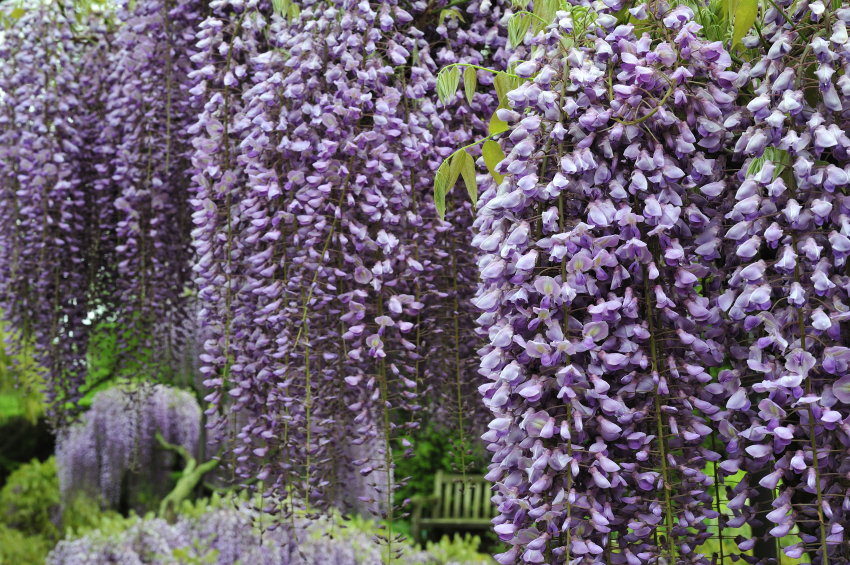In gardening circles, it is quite the fashion to extol the virtues of innocent native plants over the evil, invasive exotics. On the surface this argument looks good: native plants behave themselves because they are at peace with our varied environments, whereas non-natives run amok. If we look at the villainous behavior of certain exotics, this line of reasoning makes sense: kudzu, Japanese wisteria, and purple loosestrife, along with Elaeagnus, Japanese barberry, and mile-a-minute vine, are all imported plants that we could happily live without.
Unquestionably, native plants are a tremendous aid in providing benefits to pollinators. However, when defining "native," problems suddenly arise. Do we consider “native” just those plants that were here in North America 10,000 years ago when the future Native Americans crossed the Bering land bridge? Do we include the plants these people brought with them on their long trek from Asia? Are the plants that 17th century European settlers brought with them now considered native?
The discussion can get even more technical. For example, I live in the North Carolina Piedmont where we have lots of the Southern magnolias. Now Magnolia grandiflora only existed in one small area of eastern Carolina — and never made it to the Piedmont on its own volition. Is this a native tree or an exotic?
We forget that plants travel. We tend to view them as stationary creatures because they lack arms and legs, but through seed dispersal plants are able to colonize new territory. Consequently, it is very difficult to determine which plant is native and which plant is not.
Obviously, the horrid Microstegium, or Japanese stilt grass, which arrives on our shores in a packing box, is non-native, but what about those plants that move from the west to the east — or vice versa — in the U.S.? Is a California plant that gradually wends its way to North Carolina an exotic or a native? What about plants that slowly creep across the Rio Grande into Texas?
Native plant aficionados hasten to assure us that native plants are hardy in their native habitats because they have evolved to withstand adverse conditions. Yes, this is true for the most part, but look at the case of our native dogwood, Cornus florida. A nasty fungal disease, anthracnose, and the dogwood borer are threatening this native tree to the point that few experts advise planting it. Instead I recommend the Asian dogwood, Cornus kousa, which is far hardier than C. florida.
Rutgers University, in an attempt to save C. florida, is now marketing a new hybrid that its botanists created by crossbreeding C. kousa and C. florida. These "Stellar Series" dogwoods are great dogwoods, but can we consider them native plants? To put it crudely, C. florida and C. kousa would never have managed to hook up in the wild.
And lest we forget, we have some nasty native plants. Have you ever heard anyone extol the virtues of poison ivy, poison oak, and Virginia creeper? Ironically, the early settlers loved the fall color of poison ivy and shipped its seeds back to England. Virginia creeper, Parthenocissus quinquefolia, has managed to cover a good part of Virginia and is regularly described as “an invasive vine.” It, too, produces a lovely fall color, and it, too, can create a rash in susceptible people.
There is no question that we are losing many native plants that sustain pollinators. Due to the expansion of farmland and the use of genetically modified plants, various milkweeds are losing the battle in the Midwest. These genetically modified plants encourage the use of herbicides to the detriment of milkweed, a plant necessary for the survival of the larvae (caterpillars) of the monarch butterfly. However, this is a matter of agriculture rather than horticulture.
Please do not misunderstand me: I love many native plants, but the debate has become too one-sided when it’s a complex topic. There are good and bad plants, period. Personally, I feel there are too many gorgeous plants out there to limit myself to natives or non-natives. Just as I adore many of our native phlox, I am not about to forgo camellias, gardenias, hostas, and roses in my garden.
I am also the first to curse those plants, which never should have come to our shores, such as Rosa multiflora, all the Asian honeysuckles, and privets, among others. And remember that plants which work in one area are outlawed elsewhere. Lantana is banned both in Florida and Hawaii, but it works beautifully in North Carolina because our winters help to contain it.
Gardens are unnatural creations — otherwise we wouldn’t have to spend so much time weeding. By all means, plant “native” plants, but realize that many exotic plants are also desirable and are not necessarily thugs in the garden. Every garden contains plant groupings that wouldn’t exist in the wild. It’s OK to plant a camellia alongside our native azalea. They might even grow to like one another.









